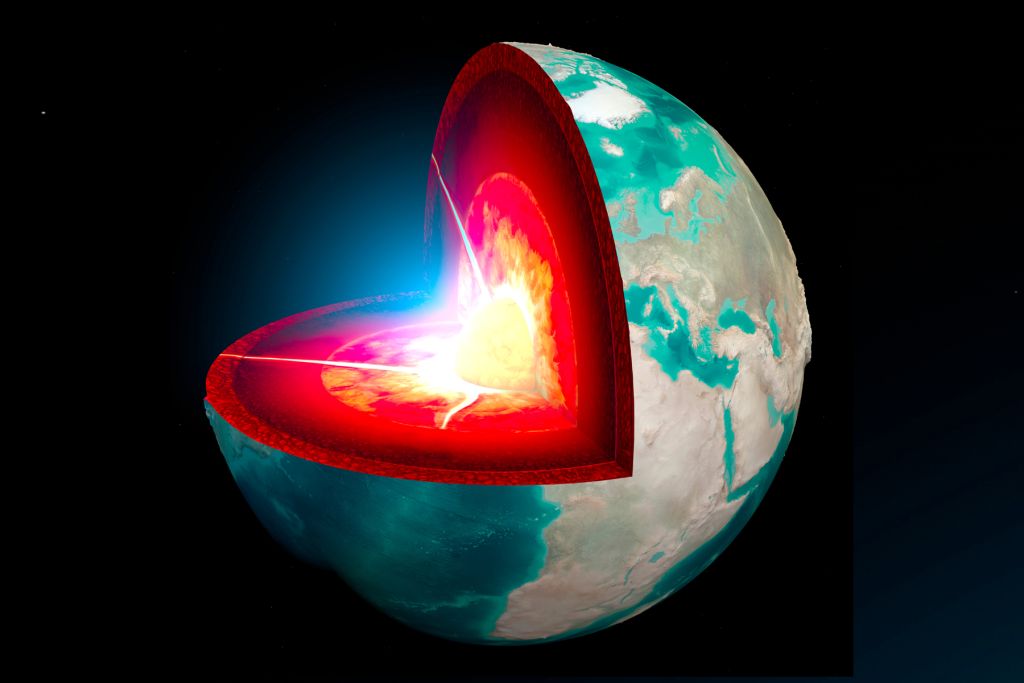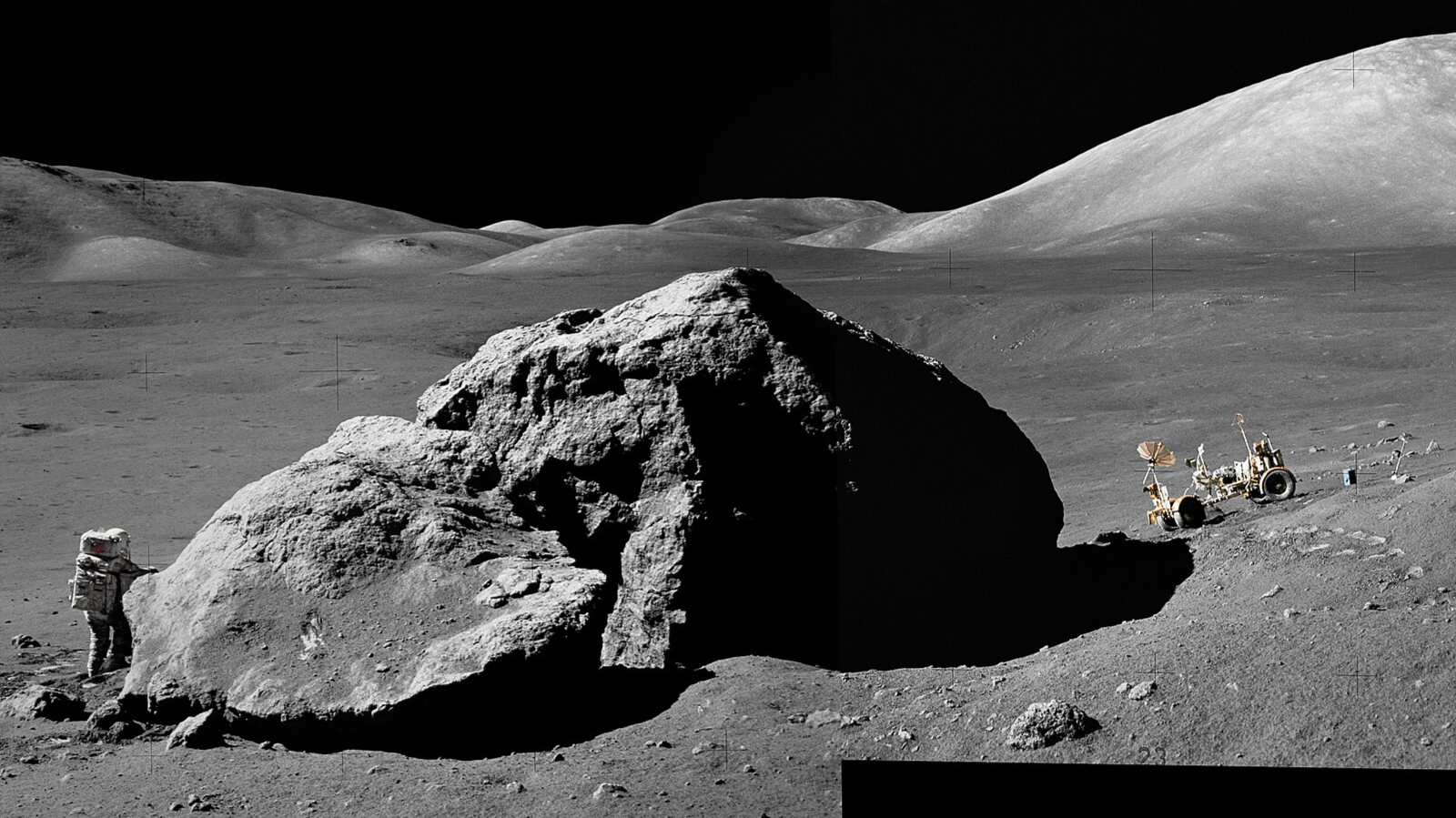Earth's core is a billion years old
The solidification of the inner core may have strengthened Earth's magnetic field.

The solid inner core of Earth is a mere billion years old, new research finds.
Modern Earth is like a layer cake, with a solid outer crust, a hot, viscous mantle, a liquid outer core and a solid inner core. That solid inner core is growing slowly as the liquid iron in the core cools and crystallizes. This process helps power the churning motion of the liquid outer core, which in turn creates the magnetic field that surrounds Earth and helps protect the planet from harmful cosmic radiation.
In other words, the inner core is pretty important.
But not much is known about the history of this 1,500-mile-wide (2,442 kilometers) iron ball. Estimates of its age have ranged from half a billion years to more than 4 billion years, almost as old as 4.5-billion-year-old Earth itself. Now, researchers have squeezed a miniscule piece of iron between two diamonds and blasted it with lasers to arrive at a new estimate of 1 billion to 1.3 billion years old — a date range that coincides with a measurable strengthening of the Earth's magnetic field that happened around the same time.
Related: Earth's layers: Exploring our planet inside and out
"Earth is unique in our solar system in that it has a magnetic field, and that it's habitable," study author Jung-Fu Lin, a geoscientist at the University of Texas at Austin, told Live Science. "Eventually our results could be used to think about why other planets in our solar system don't have magnetic fields."
The geodynamo
Earth's magnetic field is powered by what scientists call the "geodynamo." That's the movement of the iron-rich outer core, which turns the planet into a giant, if somewhat messy, magnet. The geodynamo is responsible for Earth's North Pole and South Pole and the invisible shield of magnetism that deflects and traps charged particles flowing from the sun. These particles would otherwise slowly strip Earth of its atmosphere.
Breaking space news, the latest updates on rocket launches, skywatching events and more!
Part of the movement of the inner core is powered by heat, known as its thermal energy source. As Earth's core gradually cools, it crystallizes from the inside out. This crystallization process releases energy that can further power the movement of the still-liquid outer core. This energy release from crystallization is called the compositional energy source of the geodynamo, Lin said.
Lin and his team wanted to use experimental evidence to pin down the energy from each of these sources. Knowing the amount of energy would allow them to estimate the age of the inner core.
To do this, the researchers recreated the conditions of the core on a tiny scale. They heated a piece of iron a mere 6 microns thick (about the same as the length of a red blood cell) to temperatures up to 4,940 degrees Fahrenheit (2,727 degrees Celsius), and squeezed the sample between two diamonds to match the extreme pressures at Earth's core. They then measured the conductivity of the iron under these conditions.
A young core
This conductivity measurement allowed the researchers to calculate the thermal cooling of the core that is available to power the geodynamo. They found that the geodynamo drew on about 10 terawatts of energy from the cooling core — just over a fifth of the amount of heat the Earth dissipates into space from its surface (46 terawatts, Live Science previously reported).
One they calculated the amount of energy loss, the researchers could calculate the age of the Earth's inner core, Lin said. Knowing the rate of energy loss allowed the researchers to calculate how long it would take to get a solid mass the size of today’s core from a blob of molten iron.
The 1 billion to 1.3 billion year result suggests that Earth's core is "actually relatively young," Lin said.
This estimate isn't as young as some estimates, such as one published in 2016 in the journal Nature that used similar methods but found the core was a mere 700 million years old. Lin said the new experiment used more reliable ways of handling the pressures and temperatures generated on the core, making that younger estimate unlikely.
Ancient magnetic rocks revealed that the magnetic field suddenly strengthened between 1 billion and 1.5 billion years ago, a 2015 study in the journal Nature found. The new age lines up nicely with that evidence, as the crystallization of the inner core would have provided a "boost" to the magnetic field, Lin said.
There are still questions about the way heat moves around in the core, Lin said. Unlike the sample they tested, the core isn't just iron — it also contains lighter elements such as carbon, hydrogen, oxygen, silicon and sulfur. But the proportions of these light elements are unknown, making it difficult to know how they change the conductivity of the inner core. That's what Lin and his team are working on now.
"We are trying to understand how the existence of those light elements would actually affect the thermal transport properties of iron at such high-pressure, high temperature conditions," Lin said.
The researchers reported their findings Aug. 13 in the journal Physical Review Letters.
Originally published in Live Science.
Join our Space Forums to keep talking space on the latest missions, night sky and more! And if you have a news tip, correction or comment, let us know at: community@space.com.

Stephanie Pappas is a contributing writer for Space.com sister site Live Science, covering topics ranging from geoscience to archaeology to the human brain and behavior. She was previously a senior writer for Live Science but is now a freelancer based in Denver, Colorado, and regularly contributes to Scientific American and The Monitor, the monthly magazine of the American Psychological Association. Stephanie received a bachelor's degree in psychology from the University of South Carolina and a graduate certificate in science communication from the University of California, Santa Cruz.
-
rod Interesting report indicating the *Earth's present core* must be very young compared to the age of the solar system.Reply
See 'The age of the Solar System redefined by the oldest Pb-Pb age of a meteoritic inclusion', https://ui.adsabs.harvard.edu/abs/2010NatGe...3..637B/abstract, Sep-2010. Meteorite ages with dust grains showing 4.568E+9 years old radiometric years. Also the foundation work of Clair Patterson, 'Age of meteorites and the earth', https://ui.adsabs.harvard.edu/abs/1956GeCoA..10..230P/abstract, Oct-1956.
Quite a time interval to cover here from tiny dust grains in the solar nebula 4.568E+9 years old to 1E+9 years old, present Earth's core. Many events too, e.g. giant impact with Theia and origin of the proto-Earth's core. -
Helio Reply
No, the article isn't saying that at all.rod said:Interesting report indicating the *Earth's present core* must be very young compared to the age of the solar system. -
Torbjorn Larsson It's the inner, solid core that may be that young - and the 2015 and this paper together makes a good case for such a thermally simple model - but the initial liquid core is, according to radioisotope models about 80 Myrs (IIRC). The iron-nickel liquid droplet trickled down with or without the Moon forming impact at about 50 Myrs helping - since even a small body as the Moon has a similar core - and apart from the inner solid core they now remain as the liquid outer core which makes up the geodynamo engine.Reply -
Xolas Reply
I understood the same.Torbjorn Larsson said:It's the inner, solid core that may be that young - and the 2015 and this paper together makes a good case for such a thermally simple model - but the initial liquid core is, according to radioisotope models about 80 Myrs (IIRC). The iron-nickel liquid droplet trickled down with or without the Moon forming impact at about 50 Myrs helping - since even a small body as the Moon has a similar core - and apart from the inner solid core they now remain as the liquid outer core which makes up the geodynamo engine.

